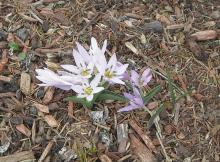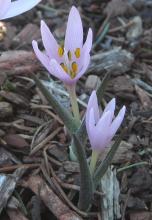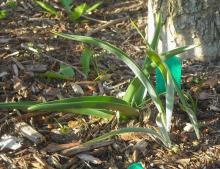Forums:
Figured there weren't enough Chionodoxa species to warrant their own thread so this one can include the miscellaneous spring bulbs. This is my first Chionodoxa forbesii (luciliae) of the season.
Figured there weren't enough Chionodoxa species to warrant their own thread so this one can include the miscellaneous spring bulbs. This is my first Chionodoxa forbesii (luciliae) of the season.
Comments
Mark McDonough
Re: Miscellaneous spring bulbs
Tue, 03/08/2011 - 4:58amFound this stunning series of photos on the "Visit West Crete" tourist web site, some excellent plant portraits there!
A floral ballet in motion: Urginea maritima - Charybdis maritima - Sea squill
http://www.west-crete.com/flowers/urginea_maritima.htm
How I would like to grow Androcymbium rechingeri, ooh la la!
http://www.west-crete.com/flowers/androcymbium_rechingeri.htm
LucS (not verified)
Re: Miscellaneous spring bulbs
Tue, 03/08/2011 - 7:04amThis one occured in cultivation no doubt, but not in my garden.
I have C. caucasica alba which is white but I don't have C. tauricola.
LucS (not verified)
Re: Miscellaneous spring bulbs
Sun, 03/13/2011 - 11:20amFritillaria season has started with us.
All from the rhinopetalum section:
(1)-(4) Fritillaria stenanthera in different clones and different colours (steelblue, pink, white)
(5)-(6) Fritillaria ariana just starting
(7)-(8) Fritillaria gibbosa
LucS (not verified)
Re: Miscellaneous spring bulbs
Sun, 03/13/2011 - 11:24amA few other Fritillaria species from Turkey:
(1) Fritillaria pinardii
(2) Fritillaria pinardii in a black form
(3) Fritillaria crassifolia ssp. crassifolia
(4-5) Fritillaria armena
Richard T. Rodich
Re: Miscellaneous spring bulbs
Sun, 03/13/2011 - 7:34pmLove that rhinopetalum section, especially!
Trond Hoy
Re: Miscellaneous spring bulbs
Mon, 03/14/2011 - 10:19amIt is clear to me that Fritillaria is best cultivated indoors! I have tried several outside but slugs devour them as fast as they germinate in spring :( (And my climate isn't the best either)
LucS (not verified)
Re: Miscellaneous spring bulbs
Tue, 03/15/2011 - 12:29pmMore bulbs to cultivate indoors for the best results :
Tulipa turkestanica
Tulipa biflora
Tulipa sogdiana, a semi-desert species
Tulipa regelii, a semi-desert species with the most remarkable leaf
Mark McDonough
Re: Miscellaneous spring bulbs
Tue, 03/15/2011 - 1:33pmRemarkable leaves indeed! Nice collection of little Tulipa species. I remember Janis Ruksans showing many others, seems there are a whole bunch of "look-alikes" with the general appearance of T. turkestanica, most notably T. bifloriformis. The latter species I find to be an excellent rock garden species outdoors, and seeds about nicely (particularly if 'encouraged' by scratching in the seed).
Trond Hoy
Re: Miscellaneous spring bulbs
Tue, 03/15/2011 - 1:52pmLuc, you certainly have an impressive collection of well grown plants!
Lori S. (not verified)
Re: Miscellaneous spring bulbs
Tue, 03/15/2011 - 7:35pmVery impressive indeed!
Of the ones shown, I know that T. turkestanica is very hardy and does well here outdoors too. I am not good with Fritillaria, although F. meleagris and F. pallidiflora are fully hardy here (and tough enough to survive my "care". ;D)
cohan (not verified)
Re: Miscellaneous spring bulbs
Wed, 03/16/2011 - 12:08amAll nice, but regelii is exquisite!
Tony Willis (not verified)
Re: Miscellaneous spring bulbs
Wed, 03/16/2011 - 1:32pmLuc absolutely stunning plants
here are a few Cyclamen pseudibericum in flower at the moment.
WimB (not verified)
Re: Miscellaneous spring bulbs
Thu, 03/17/2011 - 2:12amSome small bulbs flowering here now:
Anemone blanda 'Ingramii'
Anemone blanda 'Radar'
Erythronium dens-canis 'Pink Perfection'
Erythronium dens-canis 'White Splendour'
Fritillaria stenanthera
Fritillaria verticilliata 'Kara-Sumbe'
Olsynium douglasii 'Alba'
Ranunculus ficaria 'Aurantiacus'
Ranunculus ficaria 'Collarette'
and Ranunculs ficaria 'Wild Red Back'
LucS (not verified)
Re: Miscellaneous spring bulbs
Thu, 03/17/2011 - 7:26amFritillaria bucharica, a rhinopetalum from C-Asia - 3 shots during flowering time
Trond Hoy
Re: Miscellaneous spring bulbs
Thu, 03/17/2011 - 8:18amIt is clear to me, Luc and Wim, that the spring is far more advanced in Belgium than here in Norway - both inside and outside ;D
I have had Fritillaria bucharica outside but it was shortlived! The slugs seemingly are very fond of Fritillaria.
Tony, nice plants! How hardy are Cyclamen pseudibericum? I have several other Cyclamen species in the garden, the slugs let them alone.
Tony Willis (not verified)
Re: Miscellaneous spring bulbs
Thu, 03/17/2011 - 10:48amHoy
they have been frozen in a bulb frame this winter but only for short periods.
I have raised a batch of plants and I am going to try them outside so ask again in a year or two.
Mark McDonough
Re: Miscellaneous spring bulbs
Sun, 03/20/2011 - 8:22pmI'm late in replying, lots of good plants posted here, thanks for posting!
Last autumn I received bulbs of two forms of Colchicum kesselringii, I include a photo of one of those two forms. The following shows a form from Jane McGary, the blooms are leafless and are incredibly tiny and cute; a good candidate for a trough. The second form is a JCA collection, with flowers 4 times the size and spread wide open, with a short basal leaf showing, and taller stems (still short though), hardly seems like the same species... I have not included a photo of the second form.
Lori S. (not verified)
Re: Miscellaneous spring bulbs
Sun, 03/20/2011 - 9:34pmVery nice, Mark. It seems sort of special to me to see spring-blooming Colchicum! That reminds me... I had one C. kesselringii - the flower was very white on the petal reverse, with only the faintest purple streaking... but I haven't seen it since 2009. Oh well. :'( Must try again some day.
Mark McDonough
Re: Miscellaneous spring bulbs
Wed, 03/23/2011 - 11:23amAn update to my previous post about Colchicum kesselringii, here is a photo take on this cold gray day, showing two forms I'm growing. In the distance is the tiny form from Jame McGary, and in front of it is another form, identified as ex. S&V 94-90, HBG 1998. The Jane McGary form is leafless when in flower, and as in crocus the flowers only open in bright sun. The second form has basal foliage showing, and has flowers that are about 4x larger, with much longer tubes and splayed open flowers that stay open regardless of light. I like the smaller form better. Thanks for these JJF.
Supposed to snow starting this afternoon, so thought I'd snap some photos even with the buds closed; this is Colchicum doerfleri, another of the very small spring blooming species. I received this several years ago from friend J. John Flintoff, and they degree of hairiness is variable, some show a fringe of hairs along the leaf edges, and another is downy with fine hairs all over the leaves. After flowering, the leaves stay small and downy; a real cutie.
Richard T. Rodich
Re: Miscellaneous spring bulbs
Wed, 03/23/2011 - 6:00pmReally cool stuff Mark. The hairs are certainly an added attraction on the last one for me.
What conditions are your Colchicums growing in?
Mark McDonough
Re: Miscellaneous spring bulbs
Wed, 03/23/2011 - 8:16pmNothing special in terms of growing conditions, I typically excavate a 6" deep hole, and amend the our native rocky silty-clay soil with about 50% sand.
I went back and found a few photos from 2010, the photo on the left showing that the bulbs I received represent two forms, one only sparingly hairy but with larger more abundant light pink flowers, and one that is very hairy, with smaller less abundant deeper pink flowers. I like them both. The next two photos show the hairy foliage.
Colchicum doerfleri



WimB (not verified)
Re: Miscellaneous spring bulbs
Sun, 03/27/2011 - 7:10amWonderful Colchicums, Mark. Here they are all in leaf now as they flowered in February. Love C. doerfleri a lot...I'll have to find that species.
Here in flower now:
Corydalis bracteata
Corydalis shanginii subsp. ainae
Erythronium dens-canis 'Charmer'
Hyacinthella dalmatica
Ranunculus ficaria 'Greenpetal'
Ranunculus ficaria 'Ken Aslett'
And some Narcissus cultivars.
Mark McDonough
Re: Miscellaneous spring bulbs
Sun, 03/27/2011 - 8:57pmReally good stuff Wim, nice Corydalis, and others, we hope to get a hint of such things in the weeks to come. I have a friend that is enthusiastic about some well-behaved forms of Ranunculus ficaria. Ranunculus ficaria 'Greenpetal' certainly looks intriguing close-up. Does it have any visual impact in the garden, or is it one of those collectors "BIO plants" (an acronym borrowed from George Schenk, meaning Botanical Interest Only). I rather like this green-flowered Ranunculus, but wonder what the whole plant looks like from afar.
WimB (not verified)
Re: Miscellaneous spring bulbs
Tue, 03/29/2011 - 2:11amThanks Mark,
there are not a lot R. ficaria cultivars which are well behaved in the garden. Except maybe for the sterile doubles which don't seed around so that's one way less in which they can take over the garden. R. ficaria 'Greenpetal' hasn't got a strong visual impact in the garden. You can see in the first pic how the plant as a whole looks, it's "BIO plant" ;) (Although I must mention that I planted this cultivar this year so it might get bigger and more distinct in the following years)
The second pic is of R. ficaria 'Salad Bowl' which is one of the most beautiful cultivars to me.
Mark McDonough
Re: Miscellaneous spring bulbs
Tue, 03/29/2011 - 4:00amThese two R. ficaria cultivars are just "too cool"; love the name 'Salad Bowl' too... I think we'll be seeing StephenB over here with a name like that ;D Thanks for showing the whole plant; while understated, it has a chartreuse appeal, and the extra crinkly buds add to the effect. I will send a link to my ficaria-fancier friend, to take a look at these. I wonder what Ranunculus (aka Cliff Booker) thinks of these Rananculus?
Stephen Barstow
Re: Miscellaneous spring bulbs
Tue, 03/29/2011 - 9:39am...and here I am :)
Actually, Ranunculus ficaria does appear occasionally in my "Salad Bowl" these days! Leaves have a good mild flavour, but should only be used raw early in the spring before flowers appear (as it does become mildly toxic later on). I had been sceptical for many years and never tried it, but was persuaded by other foragers telling me that I was missing one of the best spring salad plants in addition to learning that this species has been one of the most common wild gathered edibles in the Mediterranean countries right up to present in mountain villages (used in salads and cooked). It's common name also refers to its edibility in several European languages - including the Norwegian Vaarkaal which means spring cabbage - I think that can be traced back to Linnea who wrote that it was edible.
I visited the Hortus Botanicus in Firenze (Florence) Italy a few years ago - there's a fantastic collection of wild gathered edibles including Ranunculus ficaria - you can see the sign below; it says that "stems, leaves and raw tubers, pickled buds, and a few flowers decorating salads are used". However, it also warns not to use when flowering!
Actually, what I was going to ask when I saw this thread was whether anyone had suggestions for hardy cultivars? The common and garden one is pretty hardy, but the other ones I've tried so far haven't made it - Chedglow and Green Petal for example. My quest: the tastiest ficaria cultivar ;)
Cliff Booker
Re: Miscellaneous spring bulbs
Tue, 03/29/2011 - 9:52amOh Mark,
As with politics, religion and untimely death I try to avoid discussions about R. ficaria as they seldom feature on my ranunculus radar in any way. I adore and covet all the high mountain buttercups (and appreciate and cultivate many of the less demanding species), but rank R. ficaria cultivars about as interesting and worthy of my time as snowdrops, chrysanthemums, dahlias and hyacinths. (I can hear the murmurings, catcalls and derision from here so I have invested in some earplugs before responding to your query)! :D
Mark McDonough
Re: Miscellaneous spring bulbs
Tue, 03/29/2011 - 8:30pmWell Cliff, you needn't worry about any derision from me on those, although admission of less than penultimate reverence for snowdrops is a horticultural offense in the UK, isn't it? ;D
Cliff Booker
Re: Miscellaneous spring bulbs
Tue, 03/29/2011 - 11:09pmPunishable by a lobotomy ... or certainly severe pruning!!! ;D
WimB (not verified)
Re: Miscellaneous spring bulbs
Wed, 03/30/2011 - 11:34pm;D ;D Cliff, it's a good thing tastes differ.... ;)
Mark McDonough
Re: Miscellaneous spring bulbs
Sun, 04/03/2011 - 10:52amColchicum kesselringii, starting to go over, but I like how the blooms are gently reclining. By the way, the flowers are richly fragrant on this tiny plant.
Trond Hoy
Re: Miscellaneous spring bulbs
Sun, 04/03/2011 - 10:59amA very handsome species, Mark! Even in its last days.
WimB (not verified)
Re: Miscellaneous spring bulbs
Fri, 04/08/2011 - 4:55amSome bulbs in flower here now:
Bellevalia pycnantha
Hyacinthoides italica
and Tulipa hageri 'Little Beauty'
Todd Boland
Re: Miscellaneous spring bulbs
Fri, 04/08/2011 - 10:01amNice ones Wim.....I have these as well but late May is their normal flowering time.
Trond Hoy
Re: Miscellaneous spring bulbs
Fri, 04/08/2011 - 10:57pmWim, your spring is certainly more advanced than mine!
Nice clump of the Italian bluebell you have! I grow the commom and the Spanish bluebells, the Italian I haven't tried but it seems to be a lovely plant. Does it self seed around?
WimB (not verified)
Re: Miscellaneous spring bulbs
Fri, 04/08/2011 - 11:25pmTrond,
I have it since two years and I haven't seen any seedlings yet.
Trond Hoy
Re: Miscellaneous spring bulbs
Fri, 04/08/2011 - 11:31pmWim, is that a good or bad trait? - or it is to early to tell it's nature?
The Spanish bluebell (or possibly the hybrid with the common) selfseeds everywhere her but I do not mind!
WimB (not verified)
Re: Miscellaneous spring bulbs
Sat, 04/09/2011 - 3:39amTrond,
for me that's a good trait...it's growing in my rock garden and I don't want it to take over. I'll check if it even sets seed this year and I'll let you know.
I have Spanish Bluebells in the garden too and they spread very rapidly indeed...I don't mind either.
Mark McDonough
Re: Miscellaneous spring bulbs
Sat, 04/09/2011 - 4:18pmNice miscellany Wim. I wonder how hardy Hyacinthoides italica is; my assumption is that it's not hardy here, but would like to hear the experience of others who are growing this most attractive species. 'Little Beauty' is a little beauty :D, one of my favorites here, should be in bloom in a couple weeks, the Tulipa are jumping out of the ground, with T. bifloriformis always being the first to open, and might in fact open any day now.
A couple of items, on the left is Fritillaria pudica in bud, lots of seedling plants in various years growth. On the right is Colchicum doerfleri at full anthesis (2 forms). New leaf rosettes are showing nearby, so I think I'm finally starting to see some bulb increase. This is a species appropriately sized for a trough; where it's fuzzy leaves could be seen at close hand.
Trond Hoy
Re: Miscellaneous spring bulbs
Sun, 04/10/2011 - 11:01amThanks Wim ;D
Trond Hoy
Re: Miscellaneous spring bulbs
Sun, 04/10/2011 - 11:05amMark, I am looking forward to your F pudica! I have tried it here with no luck so far, neither have I had luck with other than the most common Colchicums either :( Nice to see that you are luckier or a better gardener (or with a better climate ;)
Mark McDonough
Re: Miscellaneous spring bulbs
Sun, 04/10/2011 - 11:32amTrond, I don't think it is about being a better or worse gardener, I just don't have much of a slug problem here. From the sound of it, slugs are your main nemesis. I can understand, when I lived in the Pacific Northwest near Seattle Washington, I was overwhelmed by the constant war on gastropods. One can fight that war, or acquiesce to the situation and grow more woodies and plants not beloved by slugs. For every plant I couldn't grown in the Seattle area, there were plenty of other plants that I could grow that would be ungrowable back in the colder New England climate where I am now, it all balances out in the long run :D
So, enjoy your Rhododendron sutchuenense, it is beautiful, I wish I could grow it, but I have all but given up on growing most rhodies in my summer hot-and-dry garden and my winter cold-and-wind-dessicated garden.
Trond Hoy
Re: Miscellaneous spring bulbs
Sun, 04/10/2011 - 11:48amYes Mark, I know and agree - but I always want to have those beautiful plants that I see others are growing! I want to look at the plant in flesh and not in pixels ;D
Mark McDonough
Re: Miscellaneous spring bulbs
Sun, 04/10/2011 - 12:01pmSince I don't have a greenhouse, I have long accepted pixelated plants, thus my enthusiasm for armchair botanizing ;D
Trond Hoy
Re: Miscellaneous spring bulbs
Sun, 04/10/2011 - 12:57pmI have two greenhouses but neither are warm or very friendly in winter! And I prefere the sofa and books or magazines ;)
cohan (not verified)
Re: Miscellaneous spring bulbs
Sun, 04/10/2011 - 3:39pmNice flowers, Wim and Mark! We are almost to the stage where I could begin to believe that things could grow and flower here again, though that is still weeks away.. still more snow cover than not, but the bare areas are spreading fast-beyond paths and edges of spruce trees-- I can see things like Pyrolas and Linnaea among the dry grasses and leaves, and the first couple of semps are showing..
WimB (not verified)
Re: Miscellaneous spring bulbs
Sun, 04/17/2011 - 11:10amAlways the last Erythronium here:
Erythronium helenae
Todd Boland
Re: Miscellaneous spring bulbs
Mon, 04/25/2011 - 4:51pmLove E. helenae...saw lots of these at the 8th International Rock Garden Conference.
E. dens-canis is my first to open. Also blooming now are Scilla miczenkoana and S. bifolia 'Alba'
Stephen Barstow
Re: Miscellaneous spring bulbs
Tue, 04/26/2011 - 12:02amErythronium japonicum - is at least 1-2 weeks earlier than dens-canis.
Todd Boland
Re: Miscellaneous spring bulbs
Tue, 04/26/2011 - 2:53pmMy japonicum is about a week from flowering...had it for years but just a single sprout and flower per year and the flowers always faces AWAY from me!
Pages